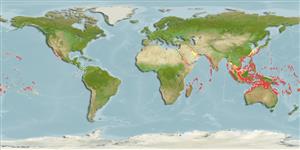>
Holocentriformes (Squirrelfishes, soldierfishes) >
Holocentridae (Squirrelfishes, soldierfishes) > Holocentrinae
Etymology: Sargocentron: Greek, sargos = sargus + Greek, kentron = sting (Ref. 45335).
More on authors: Jordan & Fowler.
Environment: milieu / climate zone / depth range / distribution range
Ecologie
marien rifbewoner; diepte 5 - 190 m (Ref. 117152), usually 5 - 70 m (Ref. 9710). Tropical; 35°N - 24°S
Indo-Pacific: Red Sea and Natal, South Africa (Ref. 4201) to the Marquesan Islands, north to southern Japan and the Ogasawara Islands, south to New South Wales, Australia.
Grootte / Gewicht / Leeftijd
Maturity: Lm ? range ? - ? cm
Max length : 20.0 cm TL mannelijk / geslacht onbekend; (Ref. 9710)
Dorsale stekels (totaal) : 11; Dorsale zachte stralen (totaal) : 13 - 14; Anale stekels: 4; Anale zachte stralen: 8 - 10. Body with red and white stripes following the scale rows, the red stripes slightly narrower than the white ones (Ref. 4201) (red stripes usually broader for Taiwan and Japan specimens); lateral line scales for northern Philippines, Taiwan and Japan specimens 44-49; 5 oblique rows of scales on cheek; body depth 2.8-3.1 in SL; head length 2.8-3.1 in SL; short snout, 3.65-4.15 in head length; interorbital width 4.3-4.65 in head length; maxilla extending from below front of pupil to below center of eye, upper jaw length 2.6-2.9 in head length; premaxillary groove reaching about a vertical at anterior edge of orbit; rounded anterior end of nasal bone; edge of small nasal fossa without spine; median edge of nasal bone (premaxillary groove margin) without spinule; upper edge of suborbital bones below the eye weakly serrated and without lateral spine; short preopercular spine, about 1/3 orbit diameter, 5.5-8.2 in head diameter; 4th or 5th longest dorsal spines, 1.7-2.2 in head length; third anal spine long, 1.15-1.4 in head length (Ref. 27370).
Occurs in outer reef slopes. A nocturnal species that feeds mainly on benthic crabs and shrimps. Spine of preopercle venomous. Solitary or in groups (Ref 90102).
Levenscyclus en paargedrag
Maturities | Voortplanting | Spawnings | Egg(s) | Fecundities | Larven
Randall, J.E., 1998. Revision of the Indo-Pacific squirrelfishes (Beryciformes: Holocentridae: Holocentrinae) of the genus Sargocentron, with descriptions of four new species. Indo-Pac. Fish. (27):105 p. (Ref. 27370)
Status op de Rode Lijst van het IUCN (Ref. 130435)
Gebruik door de mens
Tools
Speciale rapporten
Download XML
Internetbronnen
Estimates based on models
Preferred temperature (Ref.
123201): 24.7 - 29, mean 27.9 °C (based on 632 cells).
Fylogenetische diversiteitsindex (Ref.
82804): PD
50 = 0.5000 [Uniqueness, from 0.5 = low to 2.0 = high].
Bayesian length-weight: a=0.01622 (0.00774 - 0.03400), b=2.97 (2.80 - 3.14), in cm total length, based on LWR estimates for this Genus-body shape (Ref.
93245).
Trofisch niveau (Ref.
69278): 3.6 ±0.60 se; based on food items.
Weerstandsvermogen (Ref.
120179): Hoog, minimale populatieverdubbelingstijd minder dan 15 maanden (Preliminary K or Fecundity.).
Fishing Vulnerability (Ref.
59153): Low vulnerability (10 of 100).
Nutrients (Ref.
124155): Calcium = 60.9 [24.0, 255.4] mg/100g; Iron = 0.549 [0.221, 1.663] mg/100g; Protein = 18.5 [17.3, 19.7] %; Omega3 = 0.178 [0.076, 0.408] g/100g; Selenium = 43.6 [25.1, 83.3] μg/100g; VitaminA = 72.8 [28.2, 199.8] μg/100g; Zinc = 1.86 [0.77, 3.47] mg/100g (wet weight);
